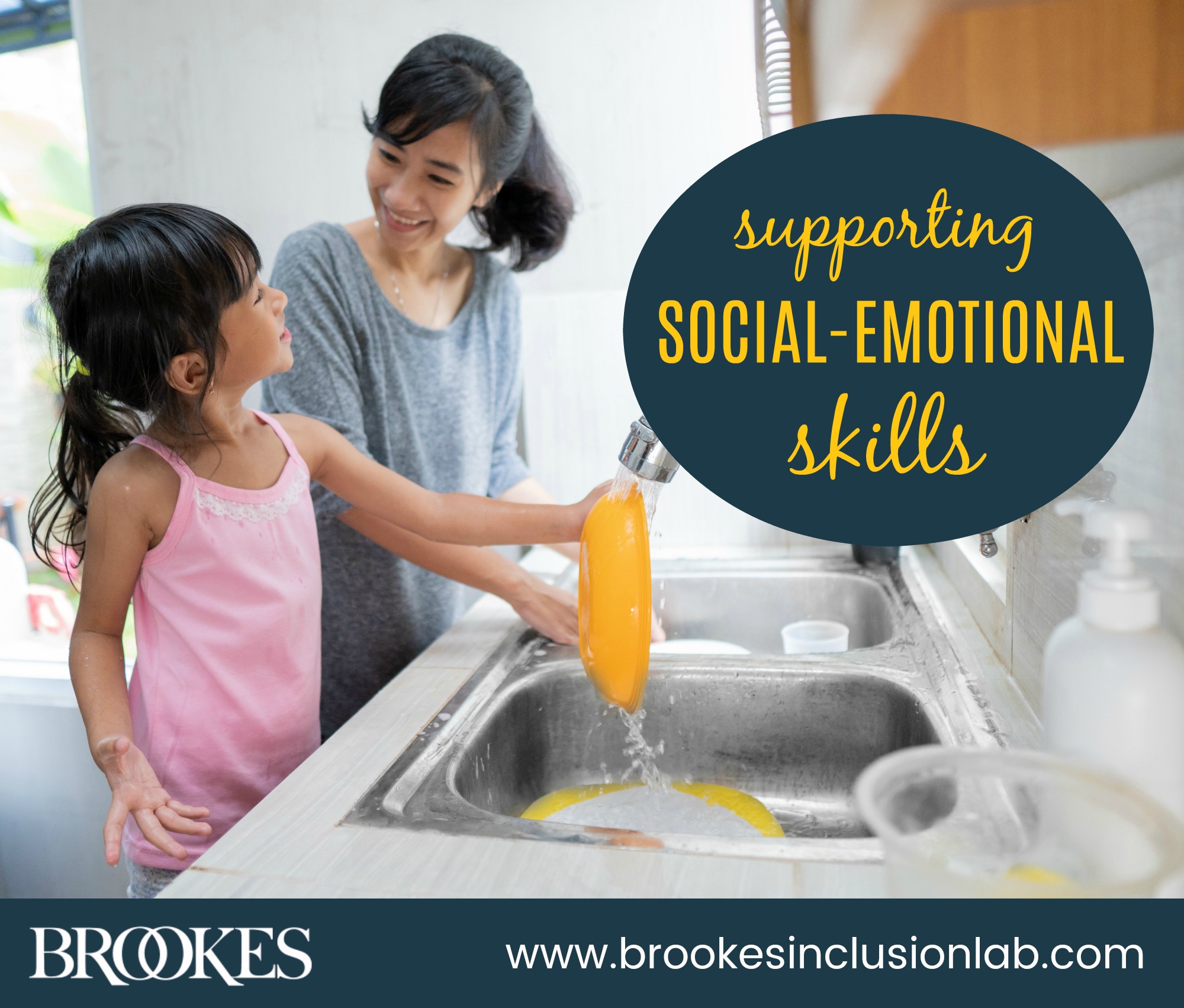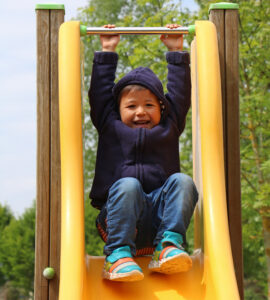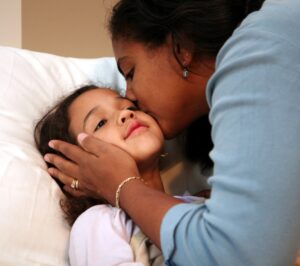11 Simple Things You Can Do To Support Young Children’s Social-Emotional Skills
October 27, 2020
The COVID-19 pandemic has ushered in months of stress, fear, and struggle for many families—and young children have felt the effects of these seismic changes just as acutely as their other family members. Paying close attention to the social-emotional development of young children is critical, now more than ever. So today we’re bringing you some simple but effective things you can do to strengthen social-emotional skills and help children build confidence, cope with big emotions, and manage stress and worry.
Whether you’re a parent or an early childhood educator, you’ll find some good tips in here for supporting early social-emotional development. For more in-depth guidance and practical strategies, check out the books referenced at the end of the post.
 Set small challenges for them. Little challenges help children learn to keep trying and develop persistence even when tasks get hard. Help kids practice the art of working through frustration and setbacks by giving them small projects that test their developing skills, such as climbing to the top of a structure or drawing a shape. Children will benefit from your verbal encouragement when they’re getting frustrated: “You can do it.” “You’re almost there—keep trying.” Showing confidence in children will help them build their own confidence and learn how to persist until the skill is mastered.
Set small challenges for them. Little challenges help children learn to keep trying and develop persistence even when tasks get hard. Help kids practice the art of working through frustration and setbacks by giving them small projects that test their developing skills, such as climbing to the top of a structure or drawing a shape. Children will benefit from your verbal encouragement when they’re getting frustrated: “You can do it.” “You’re almost there—keep trying.” Showing confidence in children will help them build their own confidence and learn how to persist until the skill is mastered.
Use music to spark conversations about feelings. Children need times when they can move around and use their arms, legs, and the rest of their body. Put on some music and dance together, using scarves or light blankets to wave around while you dance. Play different types of music, and ask children if the music sounds happy, sad, silly, mad, or scary. Talk about how the different kinds of music make each of you feel. Encourage children to make facial expressions that demonstrate the feelings they get from the music.
Communicate expectations clearly. Children feel reassured when they know what’s expected of them. Before transitioning to a new activity, identify two simple rules or expectations you might communicate to ease anxiety and help the transition go smoothly. For example, before naptime in a classroom setting, you might say “Before we have naptime, what do we need to remember? Keep quiet as a mouse so we don’t wake anybody up. Lie down and either go to sleep or just rest.” After children have heard these expectations, repeat them in part to see if children can complete your sentence. (For example, say, “Remember, during naptime, we keep…” and see if the children can complete it with “Quiet as a mouse!”) Communicating expectations is just as important at home, too, and this strategy can easily be adapted for use outside of school.
 Share appreciations at mealtime. Whether it’s a family dinner or snacktime in a classroom setting, meals provide a great opportunity to share kindness along with good food. During mealtime, have each student in your class or each family member say something kind or give thanks to another person at the table. You can talk about the word appreciation and give an example: “Tommy, I appreciated how you picked up those toys today. Thanks so much.” Model gratitude so that children learn to appreciate the people and things in their lives.
Share appreciations at mealtime. Whether it’s a family dinner or snacktime in a classroom setting, meals provide a great opportunity to share kindness along with good food. During mealtime, have each student in your class or each family member say something kind or give thanks to another person at the table. You can talk about the word appreciation and give an example: “Tommy, I appreciated how you picked up those toys today. Thanks so much.” Model gratitude so that children learn to appreciate the people and things in their lives.
Use puppets to model good behavior. Puppets are a fun and effective way to teach social-emotional skills and peaceful conflict resolution strategies. Collect a cast of store-bought or handmade puppet characters, give them names like Homer Helper and Frannie Fixer, and make up little skits and dialogues that demonstrate how to resolve problems and help peers who are upset. Modeling words and behaviors explicitly can help kids adopt kind, sharing, and helping behaviors. And the more kids show these behaviors, the less stressful your classroom or home will be for everyone.
 Read books about feelings together. Reading about other children’s feelings helps children think about their own. It also helps them know that feelings—even big ones—are okay and normal. Ask a librarian to help you find good books specific to the emotions you want to discuss; for example, if you want to help prepare children to deal with anger, read a book such as The Anger Monster by Jennifer Anzin, When Sophie Gets Angry—Really, Really Angry… by Molly Bang, or Sometimes I’m Bombaloo by Rachel Vail. Be sure to point out all of the actions or ways in which the characters behave when they are acting on their feelings. Use the following questions to guide your discussion:
Read books about feelings together. Reading about other children’s feelings helps children think about their own. It also helps them know that feelings—even big ones—are okay and normal. Ask a librarian to help you find good books specific to the emotions you want to discuss; for example, if you want to help prepare children to deal with anger, read a book such as The Anger Monster by Jennifer Anzin, When Sophie Gets Angry—Really, Really Angry… by Molly Bang, or Sometimes I’m Bombaloo by Rachel Vail. Be sure to point out all of the actions or ways in which the characters behave when they are acting on their feelings. Use the following questions to guide your discussion:
- Which character was angry?
- Do you think it was a good or not good feeling?
- What did the character look like when he or she was angry?
- What did the character do when he or she was angry?
- Did the character use a Way that Hurts or a Way that Helps to handle his or her anger?
Enlist peers as “coaches.” If you’re holding in-person classes and you see a child persisting in disruptive social behaviors, supplement your other behavior strategies by pairing them with a peer who can help model expected behavior. For example, if you have a child who repeatedly sings and calls out during quiet classroom activities, have her sit near another girl who is more skilled at staying quiet and on task. Talk to the peer “coach” privately and show her how to help her classmate by sitting next to her during quiet activities and gently tapping her own lips if her peer starts to sing or call out. Gentle reminders from classmates who are willing to provide help can be effective ways to reinforce desired social skills.
 Give them a break. Kids don’t need to be busy all the time—in fact, all children need quiet times to relax. Most childcare programs do a great job of building in calming breaks for children, but at home, you may need to plan special quiet times. Make a comfy nest with pillows, blankets, and books. When it’s possible, cuddle up together and take a break. After lunch, a rest time or a nap may help the rest of the day go more smoothly.
Give them a break. Kids don’t need to be busy all the time—in fact, all children need quiet times to relax. Most childcare programs do a great job of building in calming breaks for children, but at home, you may need to plan special quiet times. Make a comfy nest with pillows, blankets, and books. When it’s possible, cuddle up together and take a break. After lunch, a rest time or a nap may help the rest of the day go more smoothly.
Try a relaxation exercise. Help children cope with stress and worry by teaching them exercises they can do to calm themselves when they’re feeling anxious. Here’s an example that can be used in school settings or at home:
- Have children find a quiet, comfortable place.
- Ask them to sit or lie quietly. Dim the lights if possible.
- Say, “Close your eyes. Take deep breaths. Breathe in and out slowly.”
- Have them tighten their muscles, group by group. Then, ask them to loosen their muscles and make their bodies calm.
- Say, “Think about your favorite place, a place that makes you feel happy and calm.”
- Say, “Sit quietly for a few minutes and continue breathing deeply and thinking about your happy place.”
Involve children as valued helpers. Empower kids by soliciting their ideas for making their home or classroom more pleasant and functional—for example, they may suggest a more convenient arrangement for storing the blocks, or a way to create more floor space for play. Get children involved in planning and organizing special events, such as a class party or a visit from the grandparents. When it’s time to clean up or carry out another chore, work helpfully alongside the children and admire their contributions. When young children are involved in—and praised for—activities that create more comfortable and orderly living spaces, they’ll feel more safe, secure, and confident.
 Have nighttime check-ins. For parents, having a nightly check-in with a child at bedtime is a great way to explore the day’s emotions and address anything they might be struggling with, from tough or confusing situations with friends to worries about the upcoming school day. Ask the child, “How was your day?” “What was fun?” “Did anything hard happen?” With support and reassurance from a parent or other caregiver, kids can clear their mind of worries before bedtime, making it easier for them to fall and stay asleep.
Have nighttime check-ins. For parents, having a nightly check-in with a child at bedtime is a great way to explore the day’s emotions and address anything they might be struggling with, from tough or confusing situations with friends to worries about the upcoming school day. Ask the child, “How was your day?” “What was fun?” “Did anything hard happen?” With support and reassurance from a parent or other caregiver, kids can clear their mind of worries before bedtime, making it easier for them to fall and stay asleep.
***
As you try these and other strategies with the young children in your life, remember that for many kids, social-emotional issues go unrecognized before they start kindergarten. To catch any social-emotional issues early, use a reliable screening tool (such as the parent-completed ASQ:SE-2) that takes an in-depth look at social and emotional development. (Screenings are also a wonderful way to reveal social-emotional strengths, so that families can celebrate their child’s developing skills.) If the results of a screening indicate that a child needs follow-up, use a discovery and planning tool like SEAM to help develop functional goals for the child and work toward positive outcomes for the whole family.
For more tips on nurturing social-emotional development, check out these practical blog posts and explore the books referenced in today’s article.
READ MORE
12 Strategies for Building Emotional Regulation and Empathy in Young Children
The Power of Mindfulness: Practical Tips to Help Children Feel Safe and Secure
19 Simple Strategies for Helping Young Children Develop Relationship Skills
EXPLORE THE BOOKS
Tips 1, 2, 4, 8, and 11 adapted from ASQ®:SE-2 Learning Activities & More, by Elizabeth Twombly, M.S., Leslie J. Munson, Ph.D., & Lois M. Pribble, Ph.D.
Tips 6 and 9 adapted from Merrell’s Strong Start—Pre-K: A Social and Emotional Learning Curriculum, Second Edition, by Sara A. Whitcomb, Ph.D., & Danielle M. Parisi Damico, Ph.D.
Tips 5 and 10 adapted from Little Kids, Big Worries, by Alice Sterling Honig, Ph.D.
Tips 3 and 7 adapted from Early Social-Emotional Development, by Nicole M. Edwards, Ph.D.




Write a Comment
Your email address will not be published. Required fields are marked *
comments
sherri nelson says
I wish that you would make this into a pdf that could be sent out to families. It has great information!
Post a Comment